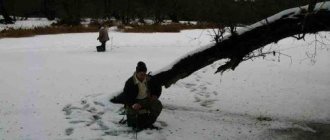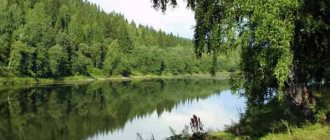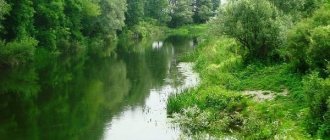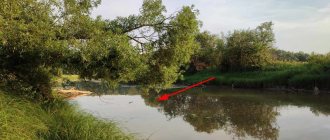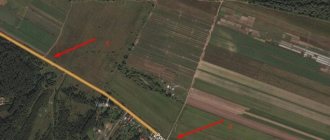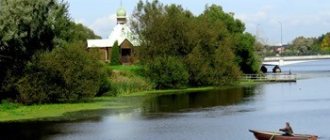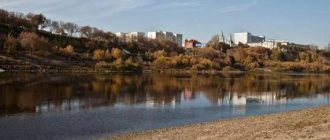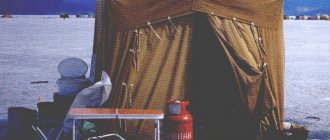Today I’ll tell you about my favorite Protva River and my own fishing experience on this beautiful, winding and picturesque river.
Since I really love fishing, I dreamed of buying a dacha near some body of water, and 8 years ago I bought a plot of land on the banks of the Protva in the Mozhaisk district of the Moscow region, literally 15 meters from the water. Over the years, I studied the bottom topography, depths, possible places for fish to stay, their habits and preferences.
Description of the Protva River.
The Protva flows in the Moscow and Kaluga regions of Russia, and is a left tributary of the Oka River. The source of the Protva River is located in the Mozhaisk district of the Moscow region, more precisely it originates on the Smolensk-Moscow Upland, flows out of a swamp near the village of Mokroe, then flows to the east, near Vereya it goes steeply to the south, from the city of Borovsk it mainly flows to the east and south- East. The Protva River flows into the Oka, about 12 km above the city of Serpukhov. In the vastness of Protva there are cities such as Vereya, Borovsk, Obninsk, Zhukov, Kremenki and Protvino.
The length of the river is 282 km, the drainage basin area is 4620 km². It feeds on snow and rain; spring floods are typical. In winter, the creeks freeze along the banks and areas with slow flows; the middle of the river, where the current is mostly intense, is not covered with ice. The largest tributary is the Luzha River. The width of the Protva in some places reaches 100 meters, but this is usually closer to the mouth, in the Kaluga region, where the elevated banks and the river cut off parts of the limestones of the Carboniferous period. The water level in Protva is characterized by a clearly defined high flood in the spring, and a low water level during the long summer seasonal standstill, interrupted by rain floods. Flood on the river usually begins in mid-March and ends by the end of April. In the photo below, the water in Protva rose 2.5 meters after heavy, prolonged rains.
The depth of the Protva River during the seasonal summer standstill in the upper reaches is from 0.5 to 2.5 meters in the pits, in the lower reaches it reaches 3.5 meters, the flow speed is generally 0.3-0.6 m/s, on the riffles 0. 8-1.0 m/s. The river bottom is rocky and sandy, and muddy in places.
Tributaries of the Protva River.
Borovna (18 km), Icha (43 km), Alozha (46 km), Ugodka (66 km), Dyrochnaya (72 km), Luzha (82 km), Isterma (119 km), Borinka (130 km), Isma ( 137 km), Mezhikha (151 km), Rut (154 km), Mzhut (204 km), Rozhenka, Konyazhenka, Berega (243 km), Karzhenka (244 km), Pesochnaya (255 km), Protovka (266 km).
Fish of the Protva River.
The following fish species live in Protva: pike, perch, chub, roach, bream, asp, ide, silver bream, bleak, rudd, gudgeon, burbot, silver carp and ruff. At the mouth of the river you can find catfish and pike perch that came from the Oka.
This is interesting: Pronya: fishing and what kind of fish is found
Fishing on the Oka River
So, today is a review of the reservoirs of the southern part of the capital region. I think I won’t be mistaken if I say that local fishermen place their hopes mainly on the beautiful Oka. Because, unfortunately, there is no other significant reservoir in the area. And we must admit that Oka fully justifies fishing hopes. After all, it enters the Moscow region in the Serpukhov region as a powerful water artery.
Suffice it to say that its width here reaches more than 200 meters with an average depth of up to two meters. And along the fairway its depth is up to 10 meters. Quiet, calm reaches give way to noisy and fast riffles. Therefore, the fishing conditions are very diverse, and therefore the gear used is different, depending on what kind of fish they intend to catch.
Review of fishing spots on the Oka River and the rivers flowing into it
And the river is rich in fish, there are more than 20 species, including bream, roach, perch, pike, silver bream, ide, chub, asp, pike perch, burbot and even catfish. There are favorite fishing spots here that are eagerly visited by fishermen. We will briefly talk about them, starting from the place where the river “confluences” with the Moscow region and following it downstream.
By the Protva River
So, at the very border of the region, near the village of Protvino, the Protva River . Fishing here suits every taste: some actively hunt for predators with a spinning rod, while others prefer quiet, calm fishing with a float rod or bottom tackle. The catches of spinning anglers include pike perch, asp, pike, perch, chub, and ide. Milkers and floaters remove bream, roach, and ide from hooks.
villages Lanshino and Drakino
Places on the opposite bank of the Oka, near the village of Lanshino, are also attractive for fishing. There are significant depths here, and therefore this place is a haven for bream hunters hunting for bream. The sand spits stretching downstream near the village of Drakino also deserve the attention of fishing lovers.
Here they are “bossed” mainly by spinning anglers, whose prey includes pike perch, pike, and asp. Lures – wobbler, spinner, jig. The section of the river at the confluence of the Skniga River is also of considerable interest. Chub, ide, asp, and roach are successfully caught on the sandbanks and spits here. And in deep-sea places - bream on the bottom.
At Lukyanovo
If you follow the downstream longer, you can find deep-water holes along the right bank near the village of Lukyanovo. This place has long been chosen by breamers. Bronze-scaled beauties weighing up to three kilograms are caught here using spinning rods. Considering that the current here is strong, and you have to cast the bait further from the shore, a heavier sliding sinker-feeder is put on the fishing line.
And here’s what’s remarkable: oddly enough, a piece of fresh lard is used as a bait for catching local bream. Even fishermen from the capital come here for large bream. Moreover, getting here is not difficult: take the train from the Kursky station to the “107th kilometer” platform, then walk towards the village of Lukyanovo and then to the Oka. And by personal vehicles - along the Simferopol highway with a turn after the road bridge over the Oka to the right towards Lukyanovo.
Fishing on Protva.
Fishing on this river is not easy, the fish are capricious and neat, especially chub, so the equipment should not be rough, with thin leads. For fishing on Protva, it is advisable to use clothing in protective colors such as camouflage, so as not to stand out from the environment, no bright or unnatural colors. Likewise, gear should be in discreet neutral colors, floats, fishing lines, braids, feeders should be combined with local vegetation. For example, when catching chub with a fishing rod, I used a homemade balsa wood float. Sometimes you carefully approach the river, and under the hanging bushes this red-feathered beauty stands and waits for a beetle, dragonfly or butterfly to fly low over the surface of the water. It is very interesting to watch this powerful predator, especially when it attacks prey.
The chub on Protva actively bites on sunny days in the riffles, but often attacks in backwaters, sometimes just in the current. On Protva it is omnivorous, but tastes and moods change very quickly. It is better to hang cranks and spinners on a spinning rod; for live bait it is better to use an ordinary bitterling, immediately caught with a landing net or a lift, he loves it. You can catch a chub with a fishing rod by placing dough or porridge on the hook, but always with the addition of fragrant vegetable oil; it really loves corn and corn sticks, and even bites on chicken liver and cheese, both processed and hard. Chub are usually caught between 0.3 and 0.8 kilograms. But local old-timers say that there are specimens weighing 1.5-2.0 kilograms.
There are a lot of fry in Protva, so the predator is generally not hungry. There is also a lot of aquatic vegetation on which herbivorous fish feed. But you can find the right approach to fish if you have patience and experiment with gear, baits and baits.
In summer, pike prefer small spinners with a silver, gold or bronze wing. In autumn and spring it goes well with jig baits, wobblers and live bait. The most active bite is in cloudy weather, on holes or under a steep bank. In the Mozhaisk region on Protva, you mainly catch specimens from 0.8 to 2.0 kilograms; further down the river in the Kaluga region, trophy toothy predators are also caught. There was a time when using a spinning rod in 40 minutes from one hole I got three pike with an average weight of 1 kilogram.
Perch on a spinning rod only goes for small multi-colored spinners, again you have to go through the entire arsenal before pleasing this striped beauty. The fishing rod only bites the worm. It lives in backwaters where there are a lot of small fish.
The easiest way to catch roach is that it is not picky. The larger ones bite on the worm, the smaller ones on corn and dough with vegetable oil, stand in the fed areas, and very rarely leave them.
Here is a description of catching the most common fish species in the Protva River, based on my experience! More information about the author can be found here...
Fishing reservoirs in the southwest of the Moscow region
Fishing on ponds and lakes
There are many ponds in this area near Moscow where you can successfully go fishing. First of all, let's consider those of them that are located along the main route in the southwestern direction - Kaluga Highway. So, let's start with the village of Voronovo, around which there are several large and fish-rich ponds. Immediately beyond the village to the right of the highway (if you are coming from Moscow), Voronovsky Pond, popular among fishermen, stretches for almost three kilometers. It is rich in a wide variety of fish, and the fish here are large. The pond is famous primarily for its carp, which reaches a weight of 10 kilograms. There are also bream, roach, perch, and pike. The pond is divided by a dam into two parts - northern and southern. In the southern half, fishing is paid.
And if you turn right at Voronov, towards the village of Yuryevki, then after about three kilometers there will be a pond no less attractive for fishing. There are a lot of perch and pike here, so the reservoir is of interest primarily for those who like to hunt for predators.
On the opposite side of the highway, if you turn left towards the village of Yudanovka, you will find several fairly large ponds rich in fish. The main fish in them is crucian carp. Although there are also roach, perch, and pike. On one of the ponds located north of Yudanovka, fishing is paid.
You can get here either by personal vehicle or by regular bus from the Teply Stan metro station to Voronov, from here you can even get to any of the named ponds on foot. Literally a few kilometers from Voronov towards Moscow, near the village of Babenki there is a large pond rich in large crucian carp and carp. They fish here with both float rods and donkeys. Directions: along the Kaluga Highway, turning left near the village of Babenki towards the village of Filino. From the turn to the pond - two kilometers.
For those who like to catch rare, noble fish, we can recommend special reservoirs where such fish are bred. There are many such ponds. For example, at the 47th kilometer along the Kaluga Highway there is a remarkable pond where fishermen can catch carp, trout, grass carp, carp, catfish, pike, and crucian carp. Fishing here, of course, is paid.
Once I had the opportunity to go fishing on this pond in pleasant company from the ice. We came specifically for trout, the weight of which here reaches two kilograms. It was in December, the coolest time. I drilled a hole, put a piece of sea shrimp (a favorite treat for trout) on a large hook of a winter fishing rod, and lowered the tackle into the hole.
And he stepped a little to the side to drill another hole. He looked around and was stunned: the fishing rod was not there. The trout, having swallowed the shrimp with the hook, swam away along with my fishing rod. I had to equip a new fishing rod, which I no longer let go of. And I experienced many exciting moments from combat with a fiercely resisting large trout, when it seemed as if someone invisible under the water was trying to snatch the tackle out of my hands.
Another similar pond is located to the right of the highway (if you are coming from Moscow), near the village of Krasnaya Pakhra. The “assortment” of fish here is also impressive: carp, grass carp, bream, trout, catfish, crucian carp, pike, perch, roach. I have fished here several times in the summer. I especially remember one of my fishing trips in May, when I caught 17 kilograms of carp!
The closest similar reservoir to Moscow in the Kaluga direction is located near the village of Sosenki, just a few kilometers from the Ring Road.
The rivers Protva, Pakhra, Nara and Desna
In the considered territory of the Moscow region, the rivers Protva, Nara, Pakhra, and Desna attract attention. They were already partially discussed in the previous publication, but there we talked only about those sections of the named rivers that are located strictly in the southern part of the region.
Middle current. In the green tunnel
From Vereya to Obninsk the most picturesque section of Protva begins. After Vereya, the river flows for more than 30 km in a narrow valley, in high banks indented by ravines in a general southern direction. Winding strongly, the Protva either slows down the flow, forming quiet reaches, or, narrowing, on the contrary, accelerates, overcoming rocky rifts. Constrictions are formed not only by the riverbed, but also by reed thickets. The width of the river ranges from 5-7 m in narrow places and up to 30 m in wide areas. There is practically no forest along the banks, but in the immediate vicinity of the water there are branches of bushes and trees hanging over it: willows, bird cherry and alder. There are many springs and streams with crystal clear water that feed the river, so even in the driest summer the Protva practically does not become shallow in this area. The river bottom is sandy, with pebbles on the riffles. In the area of the villages of Zagryazhskoye, Vyshgorod and Dubrovo, Protva forms extensive bends, with pine groves approaching the outer turns.
Having passed Dubrovo, after 1.5 km the Protva receives a large tributary on the right - the Rut River and turns sharply to the east. In this direction, still very winding, it flows about 30 km to Borovsk. The valley gradually widens, but the character of the river does not change.
The average width is already 25-40 m, the depth is 1.5-2.0 m on reaches and up to 0.5 m on rifts.
Reed and earthen islands appear in the riverbed. Vast fields of yellow egg capsule, riverine horsetail and sedge grow along the reaches. Tributaries - Mezhikha on the right, Istma, Borinka and Isterma on the left - replenish the Protva in this area. The city of Borovsk, located on the right bank of the Protva, is known for the famous Pafnutiev-Borovsky Monastery (XIV century) located nearby. In the past, the zealots of the “old faith”, Archpriest Avvakum and the noblewoman Morozova, were imprisoned in it.
Pafnutev-Borovskoy Monastery (XIV century)
Starting from Borovsk, the Protva, making large smooth bends, gradually changes the direction of the current from east to south. The population around the river is growing greatly, and, in addition to villages and holiday villages, large settlements are located on its banks: the village of Ermolino, the city of Balabanovo, the village of Krivskoye, the city of Obninsk.
In terms of fishing, the middle reaches of the Protva are very attractive. Before Borovsk, it is a river with the purest water; roach, bleak, perch, pike, and ruff live here.
The transparency of the water in Protva allows for effective hunting
There are a lot of rheophilic species: chub, dace and gudgeon; asp, silver bream and ide are found. The species composition could have been even more diverse if not for the obstacle in the form of the world's first nuclear power plant near the city of Obninsk. It is because of this that fish from the Oka does not reach the middle and upper reaches of the river. However, the dam quite significantly widens the Protva channel in this place, slows down its flow, forming an extended, deep (up to 4-5 m) reservoir reservoir. A lot of different fish come here and spend the winter safely.
Middle Protva provides an opportunity for the most demanding fisherman to prove himself. In the spring-summer period, fishing with float rods is always active here, and wiring and half-bottoms are used effectively. With the onset of warm weather and the emergence of various insects on the rapids and rifts of the Protva, it is very exciting to catch chub, dace, and sometimes asp using May beetles, grasshoppers, cabbage butterflies, and dragonflies. Use a conventional surface alloy nozzle along the stream or a bale. You can’t really count on trophy specimens, but fishing is always a lot of fun. The same predators, except dace, can be successfully caught with spinning rods, using mini-wobblers of the “Hornet” type ranging in size from 1.5 to 5 cm. The largest specimens, as a rule, are caught in the evening twilight. The best time for pike fishing is the second ten days of May. It is actively caught with a spinning rod on medium-sized “spinners” of the Long type, preferably silver in color. As the river becomes overgrown, many fishermen switch to fishing with “toothy” live bait rods, and also install stationary girders. By the way, girders are very effective in winter, especially when there is first ice.
Downstream. Among water meadows and flowering fields
3
FROM Obninsk to the village of Drakino, the lower reaches of the Protva extend over a distance of more than 90 km. Immediately after the nuclear power plant dam, the river narrows noticeably. Now its width is only 15-20 m, but the depth remains significant - 1.5-2.5 m. The banks are high and steep. The direction of the current up to the mouth is southeast. 4 km below the dam, the Protva receives its largest tributary on the right - the Luzha River, noticeably widens and becomes fuller. After a few more kilometers, it is alternately crossed by the Moscow-Kaluga railway line with the Shemyakino station closest to the river, Varshavskoe, and then the Kyiv highway. The valley expands even further, forests retreat from the river by 2-3 km, giving way to flooded meadows and irrigated fields. Only in the area of the villages of Chernaya Gryaz and Bor does a magnificent pine forest approach directly to the left bank of the river. Along the rest of the water's edge there are both individual large trees and numerous shrubs. The current of the Protva is smooth and calm; in some places there are deep whirlpools and backwaters with a reverse flow. Sandy beaches that appear in the lower reaches are often replaced by steep ravines and cliffs. There are no large tributaries in the lower reaches of the Protva, only small rivers and streams - Dyrochnaya, Ugodka, Alozha, Borovna on the left and Icha on the right replenish it in this area. But in many places in the wide valley there are numerous large and small lakes scattered, heavily overgrown in the summer, and in the spring, during the flood period, they serve as natural spawning grounds.
The population around the lower reaches of the Protva is quite high. Of the largest points, it should be noted the city of Zhukov, the village of Vysokinichi, the village of Kremenki, and the city of Protvino. By the way, opposite the village of Kremenka on the right bank of the river is the village of Troitskoye, with the family estate of E. Dashkova (18th century), the first president of the Russian Academy of Sciences, located there. Here on the river are the remains of a destroyed mill with a vast deep pool. Another ruins of a mill dam are located near the village of Yuryatino. These are the most attractive places for fishing. Almost along the entire length of the Protva, from the Kyiv highway to the mouth, there are roads along its banks at a distance of 1-3 km, so there are many approaches to the water. Fishing in the lower reaches of the Protva is quite varied and productive. During the spring flood period, a large number of fish rush from the Oka River to spawn and feed.
The most common methods of fishing in pools and deep reaches for bream, chub, large silver bream and roach: with a half-bottom or a pickerel (feeder). Fishing time: May-September. Bait: worm and steamed peas, wheat, pearl barley, oats. With the autumn cooling of the water in (October - November), using the same gear, but with live bait or dead fish (preferably ruff), they switch to catching burbot and large perch. In the spring-summer period, good results are achieved when fishing with all kinds of different-sized white fish. In this case, sufficiently high-quality, but not abundant bait is needed. The main baits are caddisfly, maggot, pearl barley, rolled oats, greens (mulberry). Fishing is also excellent with a summer jig.
Due to the strong overgrowth of the banks and the river itself, it is better to hunt with a spinning rod in spring, late autumn, and in some places (below the Obninsk nuclear power plant dam, in the area of warm discharges below the city of Zhukov, as well as from Protvino to the mouth) and in winter. In shallow water areas, riffles and reaches, rotating and oscillating spinners (especially in the non-clinging version) and floating wobblers work well. When fishing in deep reaches and in pools, it is better to use various plastic baits on jig heads weighing 5-16 g. The main trophies of a spinning fisherman are pike, perch and chub. In other years, pike perch are caught in the pre-estuary area, and once I witnessed the capture of a 7-kilogram catfish!
<<<Return to section

